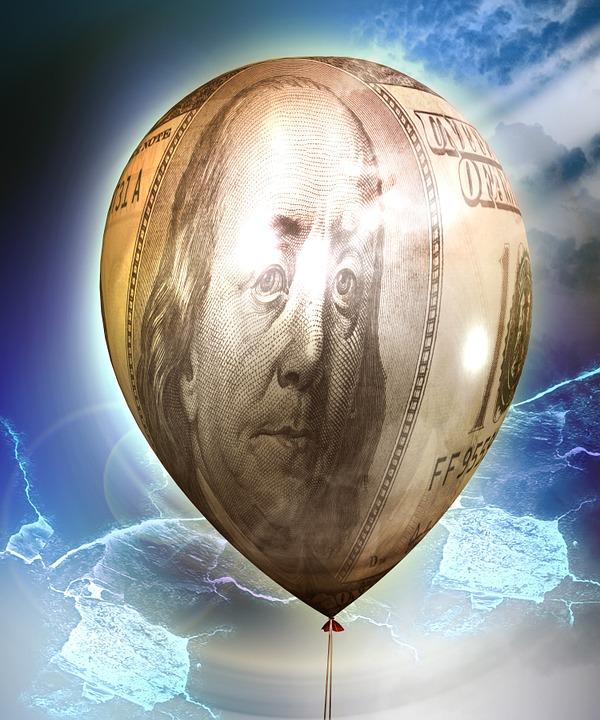The Great Inflation Mystery Summary
6 min read ⌚
 Do you know what is inflation?
Do you know what is inflation?
Before you say “a sustained increase in price level of goods and services in an economy over a period of time” – allow us to interrupt you:
Just like that definition, everything you know about inflation is mere theory.
It’s different in practice.
And this is what Peter Coy tries to demonstrate in his widely read article for Bloomberg, “The Great Mystery Inflation.”
Who Should Read “The Great Inflation Mystery”? And Why?
If you are a student in economics and you want to learn something more about inflation – this article may not help you.
Since it basically claims that we know nothing about inflation.
But that’s exactly why you should read it.
 About Peter Coy
About Peter Coy
Peter Coy is a senior writer and the economics editor for Bloomberg BusinessWeek.
After receiving a BA in history from Cornell, Coy started his journalistic career in 1980 at the “Associated Press” as an editor in the Albany bureau.
After that, he worked for some time as a correspondent at the AP Rochester bureau. In 1985, he was transferred to New York, where he worked as a business writer for the next seven years.
In 1989, Coy went to Bloomberg BusinessWeek and worked as telecommunications editor before becoming a technology editor three years later.
He has appeared on numerous TV shows on – among others – CNN, MSNBC, and the Fox News Channel.
“The Great Inflation Mystery PDF Summary”
Quick:
What’s the one thing the Antikythera mechanism and inflation have in common?
Ready?
No one knows how they work.
Really!
Last year, Daniel Tarullo, who was a member of the Board of Governors of the United States Federal Reserve Board between January 2009 and his resignation in April 2017, in a tell-all address at the Brookings Institution, said:
We do not, at present, have a theory of inflation dynamics that works sufficiently well to be of use for the business of real-time monetary policymaking.
Now, that’s not something you don’t ever like to hear!
Especially if, just half a year later, the Fed decides to increase the federal funds rate target from 1.5% to 1.75% in anticipation of inflation!
Wait a minute, you say!
Someone on the inside says that basically no one can predict the causes of inflation and its effects and that not a single person knows how to move it up or down or how low (or high) it should be – and, yet, the Fed is trying to sustain it!
But, how?
You can’t fight an enemy you don’t know!
Well, apparently you can if you are the Federal Reserve and if you ignore history.
Because it – the history – apparently shows that five out of seven times since the 1970s, the Fed went too far in raising interest rates, which resulted in “choked growth and ended in recession.”
They may be doing the same now – or they may be doing just the right thing.
Who knows?
As Coy says, “without understanding more about inflation, it’s hard to know if the Fed is tightening too quickly, not quickly enough, or at about the right pace.”
There’s one serious problem with inflation: “the prices don’t rise or fall in unison.”
In the original article, Peter Coy includes a graphic from which one can see that while the prices of financial services and insurance rose by an average of 4.4% per year between 2009 and 2017, those of gasoline and other energy goods rose by a bit more than half, i.e., 2.6%.
On the other side of the spectrum, the prices for furnishings and appliances fell by as much (2.6%), and the prices of recreational goods and vehicles fell by twice as much: 5.4%.
It’s only normal that there are discrepancies of this sort, since these prices “change for a variety of reasons, including technology, consumer preferences, and the cost of imports.”
To make matters even more complicated, inflation doesn’t hit everybody the same: the large families, the old, and the poor are usually hit hardest.
In addition, between 2014 and 2017, inflation grew differently for products bought online as compared to the same products bought at B&M stores: the inflation of the former ran 1.3% lower.
Another variance exists between the increases in prices for services versus the prices for goods.
The change in the price index for personal consumption expenditures” is, according to Peter Coy, “the Fed’s favorite measure of inflation.
Well, since the end of the last recession, it has averaged 1.5%.
However, when broken into the above mentioned two categories (goods vs. services), it shows a significant discrepancy.
Namely, while services inflation clocked in at 2.2%, goods inflation has come in at merely 0.3%.
“The average of landing at two airports is called a crash,” not-so-jokingly comments Brian Barnier, head of analytics at ValueBridge Advisors LLC in New York.
However, Peter Coy notes, that
The Fed’s challenge with inflation isn’t just a lack of knowledge; it’s also a lack of power.
In other words, Milton Friedman was probably very wrong when in 1963 he claimed that “inflation is always and everywhere a monetary phenomenon,” or, in other words, that the Federal Government can easily contain inflation by adjusting the supply of base money.
But, Friedman’s simple equation – no additional money = no price rises – has been proven wrong by practice, because the opportunity for inflation seems to increase even if the Fed does nothing, but banks start making more loans and money starts circulating faster.
Matt Busigin, a software engineer, and a portfolio manager, goes a step further.
After running tests on “20 years’ worth of data,” he found out that there’s, in fact, a negative correlation between future inflation and the increases in the Fed’s base money.
Patrick Harker, a former engineer and the president of the Federal Reserve Bank of Philadelphia, thinks this data-driven approach is the best way we can tackle the mystery of inflation, so he is keen on introducing machine learning into the art of macroeconomic predictions.
But until that time, the best thing we can do is just admit that there’s a problem and that we can’t predict inflation – instead of just pretending that we know everything about it.
Key Lessons from “The Great Inflation Mystery”
1. We Know Nothing About Inflation
2. Inflation Is a Complex Phenomenon – Not Just Monetary
3. Data-Driven Approach to Understanding Inflation May Be Our Best Bet
We Know Nothing About Inflation
Even though the Fed is trying to contain inflation by raising interest rates, the fact is that, just like everybody, they are merely shooting in the dark.
No one knows anything about inflation, including “what causes it; what effects it has; what to count in measuring it (stock prices?); how low, or high, it should be; and how to move it up and down.”
Inflation Is a Complex Phenomenon – Not Just Monetary
In 1963, Milton Friedman claimed that “inflation is always and everywhere a monetary phenomenon.”
In his opinion, in theory, the Fed should be able to exert near-total control over inflation, since prices shouldn’t rise unless the Fed prints more money.
However, in practice they sometimes do rise even if the Fed does nothing – and serious statistical studies show that, if anything, printing money may have a negative correlation to future inflations.
Why?
Simply put, because inflation is more than a monetary phenomenon.
It depends on just too many factors for us to understand it straightforwardly.
Data-Driven Approach to Understanding Inflation May Be Our Best Bet
In Peter Coy’s opinion, at the moment, the best thing we can do is simply admit that there’s a problem.
And try to find a solution for it.
Our best bet may be using data-driven approaches – as such studies done by Matt Busigin reach counter-intuitive conclusions.
Unsurprisingly, Patrick Harker, president of the Federal Reserve Bank of Philadelphia, plans to use machine learning to predict macroeconomic trends.
Who knows?
In the future, everybody may have to do it.
Like this summary? We’d like to invite you to download our free 12 min app, for more amazing summaries and audiobooks.
“The Great Inflation Mystery Quotes”
As Federal Reserve Chairman Jerome Powell and his colleagues raise interest rates to keep the U.S. economy from overheating, there’s a lot they don’t know about the foe they’re trying to contain: inflation. Share on X
Here are some of the things about inflation the Fed and other central banks are uncertain of: what causes it; what effects it has; what to count in measuring it (stock prices?); how low, or high, it should be; and how to move it up and… Share on X
Prices change for a variety of reasons, including technology, consumer preferences, and the cost of imports. Share on X
The Fed’s challenge with inflation isn’t just a lack of knowledge; it’s also a lack of power. Share on X
Neo-Fisherian ideas may have an important impact on our thinking about monetary policy in the future. (via James Bullard) Share on X
Our Critical Review
The bottom line of “The Great Inflation Mystery” is fairly simple.
In Coy’s words: “The Fed has a preferred way of measuring inflation, but it’s an open question whether the institution has the right tools to act on prices—and hence growth.”
This is such an important claim that, whether you agree with it or not, it’s exceptionally important that you read this article.
Emir is the Head of Marketing at 12min. In his spare time, he loves to meditate and play soccer.


 About Peter Coy
About Peter Coy




